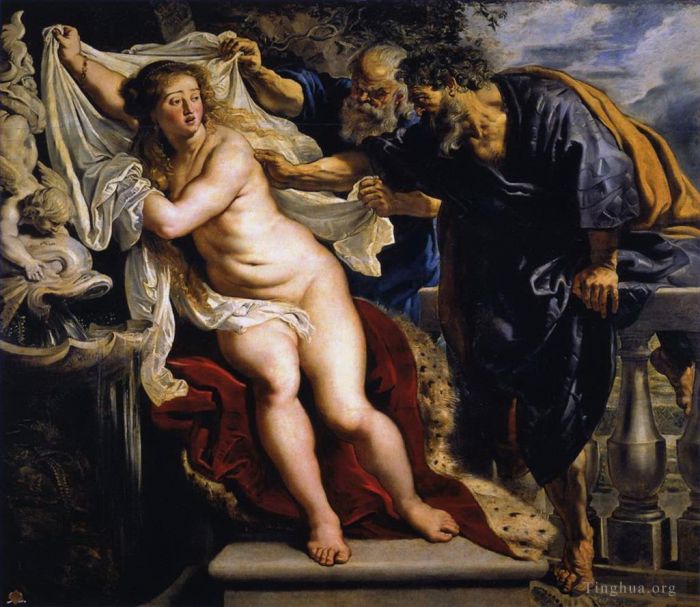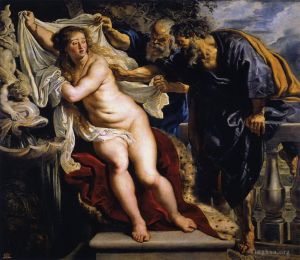Susanna and the elders 1610
Peter Paul Rubens
- Price: Price on Request
- Art Type: Oil Painting
- Size:
- English Comments: 0
- International Comments: 0
- Creating Date:
- Introduction and Works of Peter Paul Rubens >>
Work Overview
- Susanna and the Elders
Peter Paul Rubens
Date: 1609 - 1610
Style: Baroque
Genre: religious painting
Media: oil, board
Dimensions: 218 x 198 cm
Location: Real Academia de Bellas Artes de San Fernando, Madrid, Spain
As the story goes, a fair Hebrew wife named Susanna was falsely accused by lecherous voyeurs. As she bathes in her garden, having sent her attendants away, two lustful elders secretly observe the lovely Susanna. When she makes her way back to her house, they accost her, threatening to claim that she was meeting a young man in the garden unless she agrees to have sex with them.
She refuses to be blackmailed and is arrested and about to be put to death for promiscuity when a young man named Daniel interrupts the proceedings, shouting that the elders should be questioned to prevent the death of an innocent. After being separated, the two men are cross-examined about details of what they saw but disagree about the tree under which Susanna supposedly met her lover. In the Greek text, the names of the trees cited by the elders form puns with the sentence given by Daniel. The first says they were under a mastic tree (ὑπο σχίνον, hypo schinon), and Daniel says that an angel stands ready to cut (σχίσει, schisei) him in two. The second says they were under an evergreen oak tree (ὑπο πρίνον, hypo prinon), and Daniel says that an angel stands ready to saw (πρίσαι, prisai) him in two. The great difference in size between a mastic and an oak makes the elders' lie plain to all the observers. The false accusers are put to death, and virtue triumphs.
The story was frequently painted from about 1470. Susanna is the subject of paintings by many artists, including (but not limited to) Lorenzo Lotto (Susanna and the Elders, 1517), Guido Reni, Rubens, Van Dyck, Tintoretto, Rembrandt, Tiepolo, and Artemisia Gentileschi. Some treatments, especially in the Baroque period, emphasize the drama, others concentrate on the nude; a 19th-century version by Francesco Hayez (National Gallery, London) has no elders visible at all.
- Copyright Statement:
All the reproduction of any forms about this work unauthorized by Singing Palette including images, texts and so on will be deemed to be violating the Copyright Laws.
To cite this webpage, please link back here.
- >> English Comments
- >> Chinese Comments
- >> French Comments
- >> German Comments
- >>Report
- The Straw Hat (Portrait of Susanna Lunden)
- Stormy Landscape
- Decius Mus Addressing the Legions
- Entombment 1615
- Romulus and Remus
- Dance of Mythological Characters and Villagers
- Adoration of the Magi 1626
- Portrait of lady arundel with her train
- Virgin in Adoration before the Christ Child
- Boy with Bird
- The Duke of Buckingham
- The meeting of the king and marie de medici at lyons 9th november 1601625
- St augustine
- The Abduction of Ganymede
- St cecilia 1640
- Portrait of Helena Fourment
- Assumption of the Virgin
- Samson and Delilah
- Landscape with Saint George and the Dragon
- The holy family with st elizabeth 1611
- The Consequences of War
- Susanna and the elders 1610
- Christ and St. John with Angels
- Portrait of a Woman
- The Death of Seneca
- The Honeysuckle Bower (The Artist and His First Wife Isabella Brant in the Honeysuckle Bower)
- King solomon and the queen of sheba
- Duke of Lerma
- Pan and Syrinx
- Venus Cupid Bacchus and Ceres
- Saint Gregory With Saints Domitilla Maurus And Papianus
- Prometheus bound
- Adam and Eve
- The Mantuan Circle Of Friends
- Massacre of the Innocents
- The Three Crosses
- Tereus Confronted with the Head of his Son Itylus
- Madonna in Floral Wreath
- Nymphs and Satyrs
- The Fall of Phaeton
- Cimon and Pero (Roman Charity)
- The Circumcision of Christ
- Satyr and girl
- The Road to Calvary
- Christ at Simon the Pharisee
- The Meeting of Abraham and Melchizedek
- The Lion Hunt
- Daniel in the Lions Den
- Bathsheba at the fountain
- The Triumphal Car of Kallo Sketch
- Cupid making his bow
- Adoration of the Shepherds
- Mars and Rhea Silvia
- The Triumph of the Church
- Peace and abundance
- St Domitilla with St Nereus and St Achilleus
- The Last Communion of St Francis
- Descent from the Cross 1616
- Peace And War
- The Four Philosophers
- Venus in Fur Coat
- Diana returning from hunt
- Assumption of the Virgin 1626
- The Landing of Marie de Medici at Marseilles
- Mercury and Argus
- Landscape with a Rainbow 1632
- Beheading of St John the Baptist
- Christ on the Cross 1627
- Peter Paul Head and right hand of a woman
- Perseus and andromeda 1640
- Perseus and Andromeda
- Annunciation 1628
- The Resurrection of Christ
- Diana and Callisto
- The Kermesse
- Tournament in front of castle steen 1637
- Portrait of Marchesa Brigida Spinola-Doria
- The Supper At Emmaus
- Portrait Of A Man
- Rubens His Wife Helena Fourment and Their Son Frans
- Rubens In His Garden With Helena Fourment
- The Garden Of Love
- Marie de Medici Queen of France
- The Judgment of Paris 1639
- The Cardinal Infante
- Sine Cerere et Baccho friget Venus
- Battle of the Amazons
- Madonna Enthroned with Child and Saints
- Hero And Leander
- Farm at Laken
- Sine Cerere et Baccho friget Venus
- Bethrotal of St Catherine sketch
- The Triumph of Victory
- Adam and eve big
- The meeting of abraham and melchisedek 1621
- Chateau de Steen
- Peter Paul Portrait Of A Man Probably Peter Van Hecke
- Susanna and the elders
- St James the Apostle
- Christ on the Cross between the Two Thieves
- Head of a Franciscan Friar
- Return of the Prodigal Son
- Portrait of a Chambermaid Chalk
- Peter Paul Portrait Of A Woman Probably His Wife
- Portrait of Jan Gaspar Gevartius
- The Holy Family with the Basket
- The Holy Family with St Anne
- The Four Continents
- Woman with a Mirror
- Worship of Venus
- Descent from the Cross
- Deborah Kip Wife of Sir Balthasar Gerbier and Her Children
- Self portrait 1639
- Raising of the Cross Sts Amand and Walpurgis
- The rape of europa
- The Virgin and Child in a Garland of Flower
- The Judgment of Paris
- The Education of the Virgin
- Self Portrait 1628
- Sir Peter Paul Saint Felix Of Cantalice
- Portrait Of Isabella Brant
- Peter Paul Entombment
- The raising of the cross 1621
- The Elevation of the Cross (Raising of the Cross)
- The Feast of Venus
- The Deposition
- Venus und adonis
- Boar Hunt
- Garden of Love
- The Village Fete
- Portrait of Gaspard Schoppius
- Bacchus
- Roman Charity (Cimon and Pero)
- The stigmatization of st francis
- Night scene 1617
- Venus Frigida
- Leda and the Swan
- Landscape with stone carriers
- The Trinity Adored By The Duke Of Mantua And His Family
- The Statue of Ceres
- Venus and Cupid (Venus at her Toilet)
- Raising of the Cross Sts Eligius and Catherine
- The holy family with st elizabeth and the infant st john the baptist
- St George Slaying the Dragon Pen
- Hippopotamus and Crocodile Hunt
- The Crucified Christ
- Nature Adorning the Three Graces
- The drunken hercules
- Juno and argus
- The Flagellation of Christ
- The martyrdom of st sebastian
- Peter Paul Helene Fourment With Two Of Her Children Claire Jeanne And Francois Rubens
- Lamentation of Christ
- Virgin and Child 1620
- Venus at a Mirror
- Old Woman with a Basket of Coal
- Christoffel Plantin
- Martyrdom of St Thomas
- Landscape with the Ruins of Mount Palatine in Rome
- The Union of Earth and Water
- Miraculous Fishing
- The Incredulity of St Thomas
- St sebastian
- Aeneas And His Family Departing From Troy
- Altarpiece of St Ildefonso right panel
- Virgin and Child
- Fall of the Rebel Angels
- Landscape with a watering place
- Susanna and the elders
- The Adoration of the Magi
- Madonna and child with the donors alexandre goubeau and his wife anne antoni
- Head Of Medusa
- Marie de medicis as bellona 1625
- Diana and her Nymphs Surprised by the Fauns
- Landscape with cows and wildfowlers
- Pastoral scene 1638
- The Emperor Charles V
- Adoration of the Magi
- The Martyrdom of St Livinus
- Virgin And Child Adored By Angels
- The Three Graces
- The return of the farm workers from the fields
- Perseus freeing andromeda
- The Martyrdom of St Stephen
- Drunken Silenus
- Rape of the Daughters of Leucippus









 Singing Palette
Singing Palette